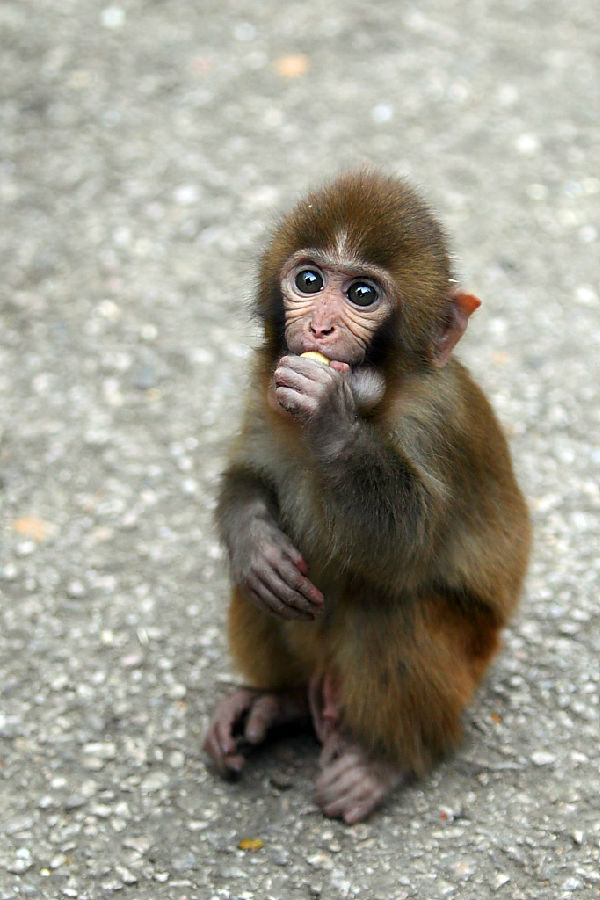(单词翻译:单击)
听力文本
This is Scientific American — 60-Second Science. I'm Karen Hopkin.
Got a minute?
We've all heard the adage: monkey see, monkey do. But it is literally true—if a monkey sees you looking at something, it will look, too. Now, a study shows that this tendency for a monkey to track what another is looking at is age-dependent. And in a very similar way to the same behavior in people.
The ability to what's called "gaze-follow" is a fundamental skill that underlies our social lives. When we turn to see what other people see, we recognize their interest and join in their curiosity—or concern. Stand on a busy street corner and look up. It won't be long before you have a crowd of people trying to see what it is you're looking at. And other primates do it, too.
Researchers studied a large population of free-ranging macaques on an island off Puerto Rico. One scientist would approach a macaque that was sitting by itself and would attempt to get its attention by clapping or snapping or by saying, "Monkey, monkey." That's lead investigator Alexandra Rosati of Harvard. When the macaque made eye contact, Rosati would look straight up in the air. A second researcher would film the interaction to see whether the monkey also looked up.

The humans pulled the same stunt on nearly 500 monkeys of all different ages, from infants just two weeks old to elders of 28 years. And they found that, for macaques, gaze following kicks in a few months after birth, peaks in juveniles, and declines in old age—a pattern that matches what happens in humans. To see the results for yourself, take a look at the write-up in the Proceedings of the Royal Society B.
The researchers also found that juvenile and adult macaques quickly figured out that Rosati was faking: when she looked up, there wasn't actually anything in particular worth seeing. At which point the clever primates disengaged from the activity. Which suggests that, yes, you can make a macaque look. But you can't make it a monkey's uncle.
Thanks for the minute for Scientific American — 60-Second Science Science. I'm Karen Hopkin.
参考译文
这里是科学美国人——60秒科学。我是凯伦·霍普金。
有一分钟时间吗?
我们都听过这句谚语:有样学样。从字面上来看这的确是正确的,如果一只猴子看到你在看某样东西,那它也会去看。现在,一项新研究表明,猴子这种仿效他人看东西的倾向与年龄有关。这与人类的同一行为非常类似。
“追随视线”这种能力是构成我们社会生活基础的基本技能。当我们转身去看其他人在看什么时,表明我们认可了他们的兴趣,而且融入他们所好奇和关心的事物中。站在一个繁忙的街角仰望天空。用不了多久,就会有一群人过来围观,想看看你在看什么。其他灵长类动物也会这么做。
研究人员对波多黎各一座岛屿上数量巨大的自由放养猕猴进行了研究。一名科学家先接近一只独自坐着的猕猴,试图通过拍手或发出啪的声音或说“猴子,猴子”来吸引它的注意力。这样做的是哈佛首席研究员亚历山德拉·罗萨蒂。当猕猴和她有眼神接触时,罗萨蒂就会抬起头直视天空。第二名研究员会拍摄下这一互动,看看这只猴子是否也会向上看。
人类在近500只不同年龄段的猴子身上进行了相同的测试,这些猴子的年龄范围从仅两周的婴儿到28岁的年老猴子。他们发现,猕猴在出生几个月后就拥有视线追随能力,这一能力在青少年时期达到峰值,年老之后衰退,这一模式与人类的情况相匹配。大家可以在《英国皇家学会学报B》上查看研究结果。
研究人员还发现,青少年猕猴和成年猕猴很快就发现罗萨蒂是在假装看东西:当她抬起头向上看时,其实并没有什么值得看的东西。这时聪明的灵长类动物就会从这个活动中脱离出来。这表明,是的,你可以让一只猕猴观看。但你不能让它感到惊讶。
谢谢大家收听科学美国人——60秒科学。我是凯伦·霍普金。
译文为可可英语翻译,未经授权请勿转载!
重点讲解
重点讲解:
1. join in 加入,参加(活动);
例句:I will join in the project, heart and hand.
我会满腔热情地参加这项工程。
2. kick in 开始生效;起作用;
例句:As discounts kicked in, bookings for immediate travel rose by 15%.
由于开始实行打折,近期旅行的预订量上升了15%。
3. figure out 想出;理解;弄清;
例句:This is something I have to figure out myself.
这是我自己必须要弄清的事情。
4. in particular 尤其;特别;
例句:Goods which are easily damaged, in particular glasses, need special packing.
容易损坏的商品特别是玻璃,需要特别的包装。


